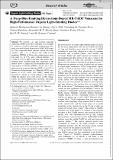A deep-blue-emitting heteroatom-doped MR-TADF nonacene for high-performance organic light-emitting diodes
Date
13/02/2023Author
Grant ID
838885
RPG-2016-047
ep/l017008/1
EP/P010482/1
Keywords
Metadata
Show full item recordAbstract
We present a p- and n-doped nonacene compound, NOBNacene, that represents a rare example of a linearly extended ladder-type multiresonant thermally activated delayed fluorescence (MR-TADF) emitter. This compound shows efficient narrow deep blue emission, with a λPL of 410 nm, full width at half maximum, FWHM, of 38 nm, photoluminescence quantum yield, ΦPL of 71 %, and a delayed lifetime, τd of 1.18 ms in 1.5 wt % TSPO1 thin film. The organic light-emitting diode (OLED) using this compound as the emitter shows a comparable electroluminescence spectrum peaked at 409 nm (FWHM=37 nm) and a maximum external quantum efficiency (EQEmax) of 8.5 % at Commission Internationale de l’Éclairage (CIE) coordinates of (0.173, 0.055). The EQEmax values were increased to 11.2 % at 3 wt % doping of the emitter within the emissive layer of the device. At this concentration, the electroluminescence spectrum broadened slightly, leading to CIE coordinates of (0.176, 0.068).
Citation
Madayanad Suresh , S , Zhang , L , Hall , D , Si , C , Ricci , G , Matulaitis , T , Slawin , A M Z , Warriner , S , Olivier , Y , Samuel , I D & Zysman-Colman , E 2023 , ' A deep-blue-emitting heteroatom-doped MR-TADF nonacene for high-performance organic light-emitting diodes ' , Angewandte Chemie International Edition , vol. 62 , no. 8 , e202215522 . https://doi.org/10.1002/anie.202215522
Publication
Angewandte Chemie International Edition
Status
Peer reviewed
ISSN
1433-7851Type
Journal article
Description
Funding: This project has received funding from the European Union’s Horizon 2020 research and innovation programme under the Marie Skłodowska Curie grant agreement No 838885 (NarrowbandSSL). S.M.S. acknowledges support from the Marie Skłodowska-Curie Individual Fellowship (grant agreement No 838885 NarrowbandSSL). We would like to thank the Leverhulme Trust (RPG-2016-047) for financial support. E.Z-C. and I.D.W.S acknowledge support from EPSRC (EP/L017008, EP/P010482/1). Computational resources have been provided by the Consortium des Équipements de Calcul Intensif (CÉCI), funded by the Fonds de la Recherche Scientifiques de Belgique (F. R. S.-FNRS) under Grant No. 2.5020.11, as well as the Tier-1 supercomputer of the Fédération Wallonie-Bruxelles, infrastructure funded by the Walloon Region under the grant agreement n1117545. Y.O. acknowledges funding by the Fonds de la Recherche Scientifique-FNRS under Grant n° F.4534.21 (MIS-IMAGINE). G. R. acknowledges a grant from the ‘‘Fonds pour la formation a la Recherche dans l’Industrie et dans l’Agriculture’’ (FRIA) of the FRS-FNRS.Collections
Items in the St Andrews Research Repository are protected by copyright, with all rights reserved, unless otherwise indicated.

